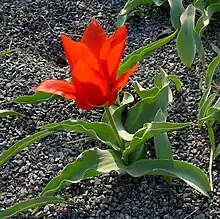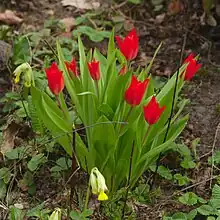| Tulipa eichleri | |
|---|---|
 | |
| Tulipa eichleri in Jardin des plantes, Paris | |
| Scientific classification | |
| Kingdom: | Plantae |
| Clade: | Tracheophytes |
| Clade: | Angiosperms |
| Clade: | Monocots |
| Order: | Liliales |
| Family: | Liliaceae |
| Subfamily: | Lilioideae |
| Tribe: | Lilieae |
| Genus: | Tulipa |
| Subgenus: | Tulipa subg. Tulipa |
| Species: | T. eichleri |
| Binomial name | |
| Tulipa eichleri | |
| Synonyms[1] | |
|
None known | |
Tulipa eichleri, commonly known as Eichler tulip or Eichler's tulip, is a species of tulip. It is a bulbous flowering perennial with long green leaves,deep red flowers with a central black blotch, coming from the Caucasus Mountains (between Europe and Asia).
It is thought to be a synonym of Tulipa undulatifolia Boiss.[2][3] or a synonym of Tulipa undulatifolia var. undulatifolia by some sources.[4]
Description

It is a perennial that grows from bulbs.[2]
It has a tall, single flowering,[2] upright stem which is covered with short hairs.[5] The plant can reach between 25–30 cm (9.8–11.8 in) tall,[6][7][8] or 10 to 12 inches tall.[9]
It has large,[10] broad,[5][7][11] strap-like leaves.[2] They are grey-green,[12] or glaucous (bluish-green) with slightly undulating or wavy edges.[7]
It flowers in early Spring,[11][12][13] between April and May.[6][8][14]
It has large flowers,[12][11][6] one of the largest flowers of all the species tulips.[7] They are bell shaped,[15][7] or goblet-shaped,[2] They don't have sepals, petals or bracts, just five simple tepals.[13] The segments are obovate or obtuse in shape.[10][14] The flower almost resembles the flowers of Tulipa gesneriana but differs in having a pubescent peduncle (flower stalk).[14]
Tulipa eichleri flowers come in shades of red, from scarlet,[10][15][16] bright red,[17][18] orange,[19] orange-red,[12] crimson,[8][14] to deep red.[11] They also have a dark basal blotch,[15][7] which is blue-black,[11] or black.[16][10][18] The blotch has a yellow ring,[12] margin,[15] or border around it.[10][6][14]
The flowers close at night and they can resemble a "Christmas present with a bow on top".[13]
Biochemistry
Anthocyanins have been found in various tulip flowers, such as Tulipa gesneriana, Tulipa fosteriana and also Tulipa eichleri.[20]
Taxonomy
_Curtis_Bot_Mag_V_101_t_6191_(1875).jpg.webp)
The Latin specific epithet eichleri refers to German botanist August W. Eichler who found the tulip in the Caucasus.[22]
It has the common name of 'Eichler Tulip' [11] or 'Eichler's Tulip'.[8][3]
It was first found in Turkestan,[23][16] and then described and published as Tulipa eichleri by Eduard August von Regel in his botanical magazine 'Gartenflora' Vol.23 on page 193 in 1874.[1][24][23]
It was then first cultivated in England in 1876 with bulbs sent by Prof. Eduard Regel.[25]
In June 1932, it was given the RHS's Award of Garden Merit.[26]
In 1982, David Mabberley in Taxon Vol.31 on pages 65–73, William Roxburgh's 'Botanical description of a new species of Swietenia (Mahogany) and other overlooked binomials in 36 vascular plant families'. He then renamed it as a synonym of Tulipa persica (Lindl.) Sweet (as it was native to Iran).[4]
Then in 1984, P.H. Davis, in 'Flora of Turkey and the East Aegean Islands' Vol.8 on pages 1–632. It was renamed as Tulipa undulatifolia,[4] which was agreed by the botanists at Kew.[13] The RHS considered it to be a synonym of Tulipa undulatifolia Boiss,[3] so do the United States Department of Agriculture and the Agricultural Research Service as of 6 August 2013.[27] It is also in the World Economic Plants book as Tulipa undulatifolia,[28] and other sources.[9]
Then in 2013, D. Everett, in his book 'The genus Tulipa, Tulips of the world' by Kew publishing. He cited it as Tulipa undulatifolia var. undulatifolia.[4] This name was accepted by the Pacific Bulb Society.[15]
Although, Tulipa eichleri is still an accepted name by some botanic sources.[29][30][31]
Distribution and habitat
Tulipa eichleri is native to temperate areas of Central Asia.[27]
Range
It is found in Turkey (previously known as Asia Minor,[8]) and Iran,[15][3][7] and the Caucasus Mountains,[3][6][32] including the Transcaucasian region (South Caucasus or Georgia),[5][33][34] and Azerbaijan.[32]
Habitat
It is found on dry slopes and in shrubby woods within the lower mountain belt altitudes.[32]
It grows on the steppes of Georgia, with other plant species such as Seseli granivittatum, Teucrium nuchense, Teucrim pollium, Thymus tifisiensis, Scorzonera eriosperma, Psephellus carthialinicus, Carex bordzilowskii, Tulipa biebersteinii and Iris iberica.[33]
Conservation
It is very rare in the wild and is only occasionally cultivated.[13]
It is listed (as part of the IUCN Red List or Red Data Book) as a Georgian Red Data species.[35][36]
500 seeds have been placed in the Millennium Seed Bank Project.[35]
In Georgia, the locations of many rare species (Tulipa eichleri and Iris iberica) are decreasing in numbers. Especially, near the roadsides and near the settled areas. This is due to the decimation of vegetation cover. Also, the impacts of irrigation systems and the change of use into land for agriculture (to grow cotton grass, wheat, barley, corn, and vines).[37]
Cultivation

It is only occasionally cultivated and generally only grown by specialist tulip growers,[13] as it is also used for hybridization purposes.[7]
It is hardy down to -30 °F.[11] In America, this equates to USDA Zones 4 through 8.[9] A hot dry summer and cold winter is essential for the plant to re-flower again, so in warmer climates it is recommended that the bulbs should be dug up and chilled for 3 – 4 months and then planted out in mid winter or spring.[7] They can remain undivided for several years within garden borders, rock gardens and in naturalized (grassy) areas,[12][7] or in pots or containers, if they are given a feed of a top dressing every autumn.[8] They can tolerate positions in full sun to partial shade,[12] but prefer a sunny position.[7] in soil that is humus rich, moist and well drained.[7] They should be planted in fall or spring, 8 cm (3.1 in) apart and 13 cm (5.1 in) deep.[7]
It is thought to be a vigorous plant that will multiply rapidly,[6][9] but it can be propagated by offsets (mini bulblets coming off the side of the main bulb), but it may take up to 3 years before they flower.[6] It is recommended that gardeners allow the foliage to die back or fade. Then the flower heads can be removed after blooming (or remove the seed pods, if they develop). These actions will allow the energy to go back into the bulb to produce next year's flowers.[12]
Culture
In 1993, a postage stamp in Azerbaijan, within the flowers series was issued with a image of the tulip.[38]
References
- 1 2 "Tulipa eichleri Regel is an accepted name". theplantlist.org. Retrieved 18 September 2017.
- 1 2 3 4 5 "Tulipa undulatifolia Boiss. (Eichler's tulip)". Retrieved 18 September 2017.
- 1 2 3 4 "Tulipa eichleri Regel | Plants of the World Online | Kew Science". Plants of the World Online. Retrieved 3 April 2021.
- 1 2 3 Vera Higgins (editor) Some Good Garden Plants, Containing Descriptions of the Plants which Have Received the Award of Garden Merit, 1922-1945 (Royal Horticultural Society 1946), p. 75, at Google Books
- 1 2 3 4 5 6 7 "Ivydene Gardens Tulip Bulb Gallery: Classification Division 15 - Specie". Retrieved 3 April 2021.
- 1 2 3 4 5 6 7 8 9 10 11 12 13 14 "Tulipa eichleri | NurseriesOnline USA". Nurseries Online. Retrieved 2 October 2023.
- 1 2 3 4 5 6 Henrietta M. Batson A Concise Handbook of Garden Flowers (1903), p. 213, at Google Books
- 1 2 3 4 Heath, Becky. "Wildflower Tulips". garden.org. Retrieved 2 October 2023.
- 1 2 3 4 5 "Tulip". LoveToKnow. Retrieved 11 April 2021.
- 1 2 3 4 5 6 7 Mike Heger, John Whitman and Debbie Lonnee Growing Perennials in Cold Climates (1998), p. 369, at Google Books
- 1 2 3 4 5 6 7 8 "Tulipa eichleri". www.digdropdone.com. Retrieved 1 October 2023.
- 1 2 3 4 5 6 Avis-Riordan, Katie. "Top plant picks: Kew scientists reveal their favourites". kew.org. Retrieved 3 April 2021.
- 1 2 3 4 5 George Nicholson (Editor) The Illustrated Dictionary of Gardening: A Practical and Scientific Encyclopedia of Horticulture for Gardeners and Botanists, Volume 4 (1889), p. 104, at Google Books
- 1 2 3 4 5 6 7 "Tulipa Species Two". www.pacificbulbsociety.org. 13 May 2015. Retrieved 18 September 2017.
- 1 2 3 Herbert Ernest Bates The Seasons & the Gardener: A Book for Children, p. 29, at Google Books
- ↑ Arend Jan van der Horst and Jan Bader The Tulip: Symbol of Sun and Spring (2001) at Google Books
- 1 2 Christopher Lloyd A Year in the Garden with Christopher Lloyd, p. 325, at Google Books
- ↑ Boston (Mass.) Superintendent of Common and Public Grounds Annual Report of the Superintendent of Common and Public Grounds 1889, p. 40, at Google Books
- ↑ N. Marissen, W. G. van Doorn and U. van Meeteren, International Society for Horticultural Science Proceedings of the Eighth International Symposium on Postharvest Physiology of Ornamental Plants, 2005, p. 248, at Google Books
- ↑ Indian National Science Academy Proceedings, Volume 45, Part 2, 1979 at Google Books
- ↑ Archibald William Smith A Gardener's Handbook of Plant Names: Their Meanings and Origins, p. 140, at Google Books
- 1 2 "Liliaceae Tulipa eichleri Regel". ipni.org. Retrieved 18 September 2017.
- ↑ Eduard August von Regel Gartenflora, Volume 23 , p. 192, at Google Books
- ↑ H.J. Elwen The Garden: An Illustrated Weekly Journal of Gardening in All Its Branches, Volume 9, 1876 at Google Books
- ↑ Frederick James Chittenden RHS, Some Good Garden Plants (1938), p. 136, at Google Books
- 1 2 "Tulipa eichleri Regel". npgsweb.ars-grin.gov. Retrieved 18 September 2017.
- ↑ John H. Wiersema and Blanca León World Economic Plants: A Standard Reference, Second Edition (1999), p. 702, at Google Books
- ↑ Zonneveld, B.J.M. (2009). "The systematic value of nuclear genome size for "all" species of Tulipa L. (Liliaceae)". Plant Syst. Evol. 281 (1–4): 217–245. doi:10.1007/s00606-009-0203-7. S2CID 28406617.
- ↑ Takhtajan, A.L., ed. (2003–2012). Konspekt flory Kavkaza [Caucasian Flora Conspectus] (1–3 ed.). Saint Petersburg: KMK Scientifik Press. pp. 1–466.
- ↑ Van Raamsdonk, L.W.D.; De Vries, T. (1995). "Species Relationships and Taxonomy in Tulipa subgenus Tulipa L." Plant Systematics and Evolution. 195: 13–44. doi:10.1007/BF00982313. S2CID 20898836.
- 1 2 3 "MBG: Research: Rare, Endangered and Vulnerable Plants of the Republic of Georgia". www.mobot.org. Retrieved 1 October 2023.
- 1 2 George Nakhutsrishvili The Vegetation of Georgia (South Caucasus), p. 26, at Google Books
- ↑ Akhalkatsi, Maia AU; Kimeridze, Mariam (February 2017). "Diversity of Georgian flora relationship of the Earth's climate". The Union of Nature Explorers "Orchis" Journal. 4: 1–24.
- 1 2 Mikatadze-Pantsulaia, Tsira; Barblishvili, Tinatin; Trivedi, Clare; Kikodze, David; Khutsishvili, Manana (2010). "Ex situ conservation of some endemic and protected plant species in Georgia". Kew Bulletin. 65 (4): 643–648. doi:10.1007/s12225-010-9242-z. S2CID 25157567.
- ↑ Kacharava, V.; Ketskhoveli, N.; Kurashvili, B.; Maruashili (1982). Red Data Book of the Georgian SSR (Rare and Endangered Species of Animals and Plants, Some Monuments of Inorganic Nature) (in Georgian). Tbilisi: Sabchota Sakartvelo Press.
- ↑ Nikolaishvili, Dali (26 April 2022). "Plant Diversity and General Vegetation of Georgia". In Öztürk, Münir; Altay, Volkan; Efe, Recep (eds.). Biodiversity, Conservation and Sustainability in Asia. Springer Cham. pp. 393–420. ISBN 978-3-030-59930-0.
- ↑ "Stamp › Tulipa eichleri". colnect.com. Retrieved 7 April 2021.
Other sources
- Aldén, B., S. Ryman, & M. Hjertson Svensk Kulturväxtdatabas, SKUD (Swedish Cultivated and Utility Plants Database; online resource on www.skud.info). 2012 (Kulturvaxtdatabas)
- Erhardt, W. et al. Zander: Handwörterbuch der Pflanzennamen, 17. Auflage. 2002 (Zander ed17)
- Huxley, A., ed. The new Royal Horticultural Society dictionary of gardening. 1992 (Dict Gard)
- Komarov, V. L. et al., eds. Flora SSSR. 1934-1964 (F USSR)
- Marais, W. 1980. Notes on Tulipa (Liliaceae) Kew Bull. 35:259.
- Rechinger, K. H., ed. Flora iranica. 1963- (F Iran)
- Walters, S. M. et al., eds. European garden flora. 1986- (Eur Gard F)